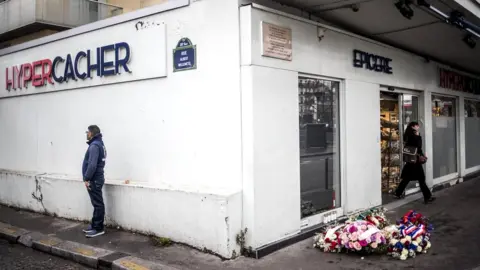Charlie Hebdo: Magazine republishes controversial Mohammed cartoons
 EPA
EPAFrench satirical magazine Charlie Hebdo has republished cartoons of the Prophet Mohammed that made them the target of a deadly terror attack in 2015.
Republication comes a day before 14 people go on trial accused of helping the two Islamist attackers carry out their gun rampage on 7 January 2015.
Twelve people were killed, including famous cartoonists. Five people died in a related attack in Paris days later.
The attacks began a wave of jihadist strikes across France.
The front cover of the latest edition features the 12 original cartoons of the Prophet Mohammed, which were published in a Danish newspaper before appearing in Charlie Hebdo. One of the cartoons shows the prophet wearing a bomb instead of a turban. The French headline reads "Tout ça pour ça" ("All of that for this").
In its editorial, the magazine says that it has often been asked to carry on printing caricatures of the prophet since the 2015 killings.
"We have always refused to do so, not because it is prohibited - the law allows us to do so - but because there was a need for a good reason to do it, a reason which has meaning and which brings something to the debate," it says.
"To reproduce these cartoons in the week the trial over the January 2015 terrorist attacks opens seemed essential to us."
What's expected at the trial?
Fourteen people are accused of obtaining weapons and providing logistical support for the attackers of Charlie Hebdo's Paris offices, and subsequent attacks on a Jewish supermarket and a police officer.
 EPA
EPAThree of the accused are being tried in absentia as they are believed to have fled to northern Syria and Iraq.
There are believed to be some 200 plaintiffs in the trial and survivors of the attacks are expected to testify, France's RFI broadcaster reports.
The trial had been due to start in March but was postponed because of the coronavirus pandemic. It is due to last until November.
What happened in 2015?
On 7 January, brothers Said and Cherif Kouachi stormed the offices of Charlie Hebdo, and opened fire killing the editor Stéphane Charbonnier, known as Charb, four other cartoonists including Cabu, two columnists, a copy editor, a guest attending the meeting and the caretaker. The editor's bodyguard and a police officer were also killed.
As police hunted down the two brothers - who were eventually killed - another siege began in the east of Paris. Amedy Coulibaly, who was an acquaintance of the Kouachi brothers, killed a policewoman before taking several people hostage at a Jewish supermarket. He killed four Jewish men on 9 January before being shot dead in a police standoff.
In a video recording, Coulibaly said the attacks had been carried in the name of the Islamic State group.
Why was Charlie Hebdo a target?
Charlie Hebdo's anti-establishment satire - poking fun at the far right, and aspects of Catholicism and Judaism as well as Islam - had long drawn controversy.
But it was its portrayals of the Prophet Mohammed that led to death threats against the editorial team and a petrol bomb attack on its offices in 2011.
Charb had strongly defended the cartoons as symbolic of freedom of speech. "I don't blame Muslims for not laughing at our drawings," he told the Associated Press in 2012. "I live under French law. I don't live under Koranic law."
Following the 2015 attack, thousands of people took to the streets in protest and the hashtag #JeSuisCharlie (I am Charlie) began trending around the world.
Managing editor Gerard Biard told the BBC in 2016 that the magazine's emergence as an international symbol had brought with it fresh criticism of its provocative and controversial tone, with many people calling for it to have more respect for the views - and beliefs - of others.
